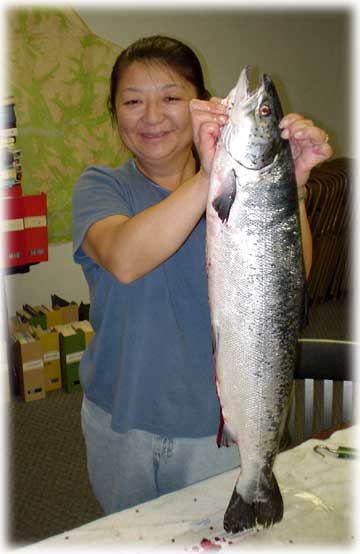 July 24, 2004
"The fish, which is 8.3 pounds, appears to be in good condition," said Glenn Hollowell, a Fishery Biologist in the ADF&G Ketchikan office. It is unclear whether this fish is one of 2,587 Atlantic salmon that escaped from a farm in British Columbia between July 5-10, while being transferred into an un-inspected net with holes in it. "Regardless of the origin of this fish, it is important to understand the potential danger that Atlantic salmon present to Alaska's wild salmon stocks," said ADF&G Invasive Species Program Coordinator Bob Piorkowski. "Introduction of non-native species, including Atlantic salmon, into Alaska's fresh and salt waters could result in unexpected and potentially catastrophic consequences ranging from serious reduction of native species and habitat destruction to economic damage." According to information provided by the ADF&G, since 1994, 577 Atlantic salmon have been found in Alaska's waters, including freshwater systems such as the Copper and Situk rivers. ADF&G urges the public to be vigilant and to actively watch for Atlantic salmon in Alaska's fresh and salt waters. Atlantic salmon are identified by a number of markings, such as black x-shaped spots on the back above the lateral line and black spots on gill covers. Free wallet-sized ID cards with this information are available at most coastal ADF&G offices. The Alaska Department of Fish and Game requests that if you see or catch an Atlantic salmon, to please: (1) note the location; (2) keep the entire carcass (freeze if necessary); and (3) call the ADF&G Atlantic Salmon Watch Program toll free at 1-877-INVASIV or 1-877-468-2748. Captured Atlantic salmon should never be cleaned, but should be delivered whole to the nearest ADF&G office. 
Source of News Release, photos & for additional information:
|
||
